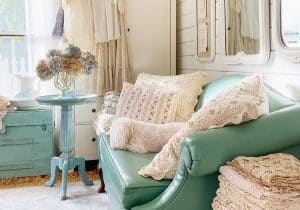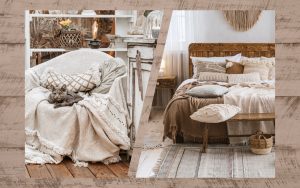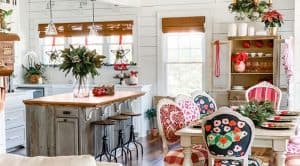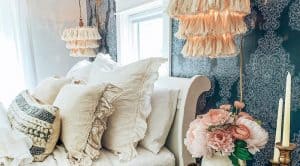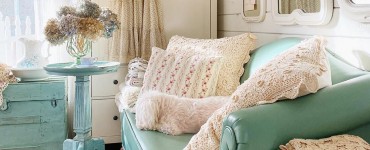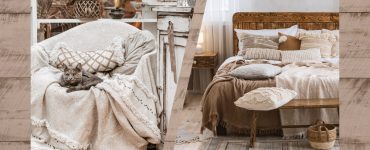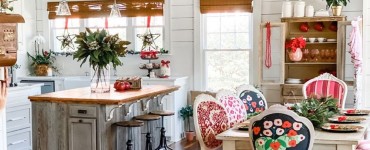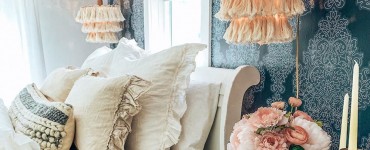If you’re enchanted by the charm of vintage aesthetics, soft pastels, and rustic elegance, then Shabby Chic might be the perfect interior design style for you. Shabby Chic is a timeless and popular decor approach that effortlessly blends old-world charm with a touch of modern whimsy. One of the key elements that define this style is the use of paint colors that exude a romantic, distressed, and lived-in vibe.
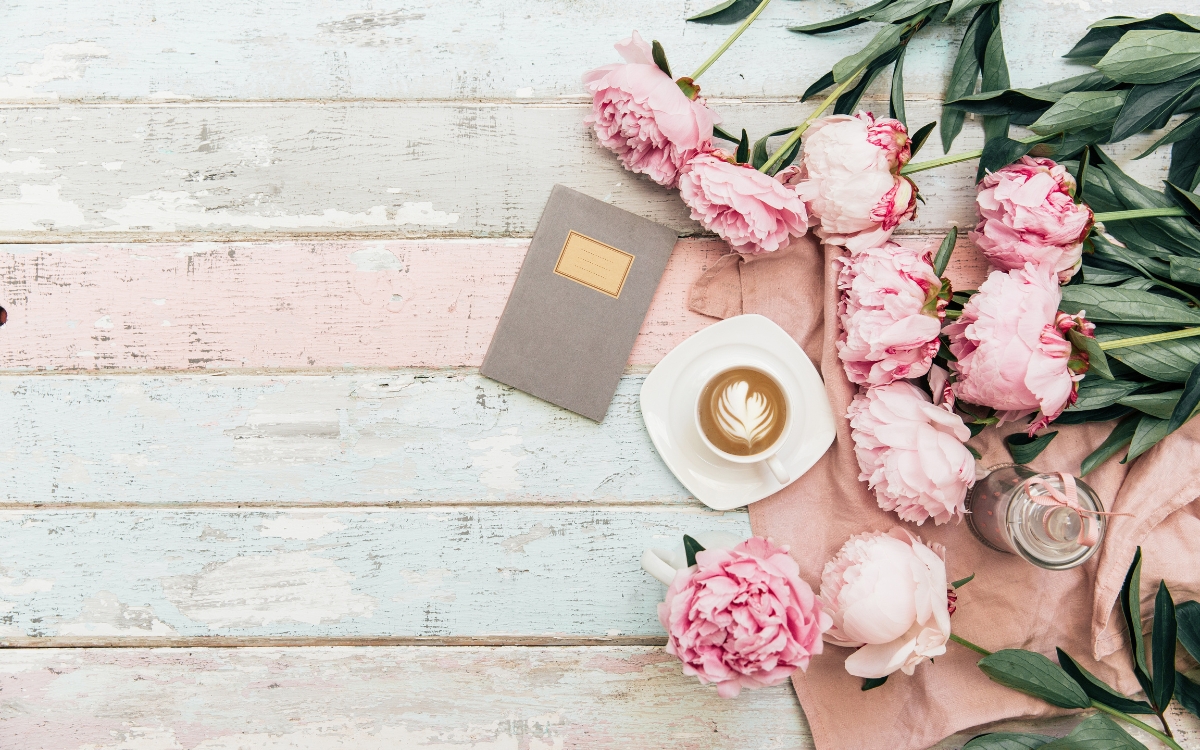
In this comprehensive blog post, we’ll take you on a journey through the world of Shabby Chic paint colors, exploring the essence of this captivating style and the magic of selecting the right hues for your space. Whether you’re revamping an entire room or adding subtle touches of Shabby Chic to your existing decor, we’ve got you covered.
Understanding the Basics of Shabby Chic Paint Colors
Shabby Chic, a beloved interior design style that embraces the allure of vintage aesthetics and faded elegance, is characterized by its use of soft, romantic paint colors that create a sense of timeless charm and comfort. In this section, we will delve into the essence of Shabby Chic paint colors and explore the key elements that make them an integral part of this captivating decor approach.
The Allure of Shabby Chic Paint Colors
Shabby Chic paint colors hold a unique allure that sets them apart from other interior design palettes. They are chosen to evoke a feeling of nostalgia, delicacy, and grace, reflecting the beauty of faded grandeur and well-loved pieces. Unlike bold and vibrant hues, Shabby Chic colors are subtle, soothing, and ethereal, offering a serene ambiance that calms the senses and welcomes relaxation.
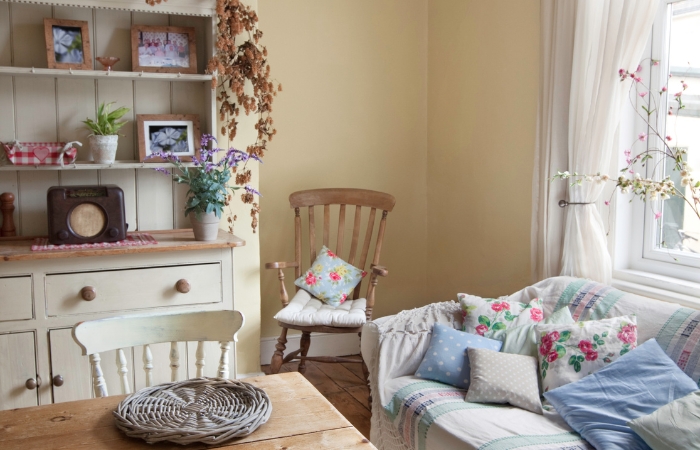
Embracing the Distressed Look
A fundamental aspect of Shabby Chic paint colors is their ability to embrace the distressed look. This weathered and worn appearance adds character and depth to the decor, giving it an inviting and lived-in feel.
The distressed effect often involves creating a sense of age on furniture and walls, as if they have withstood the test of time and carry a history of their own. This harmonious blend of elegance and imperfection is what makes Shabby Chic so captivating.
Characteristics of Shabby Chic Paint Colors
Shabby Chic colors are characterized by their softness, subtlety, and vintage-inspired undertones. Pastel hues take center stage, including light pinks, baby blues, mint greens, and lavender shades.
Neutral tones, such as beige, cream, and soft greys, play a crucial role in creating a balanced canvas that complements the other elements of Shabby Chic decor. Vintage reds and roses add a touch of passion and warmth to the palette, while earthy tones like browns and greens infuse rustic charm and natural beauty.
Exploring the Timeless Appeal of Pastels
Pastel hues hold a timeless appeal that transcends trends and fads, making them a quintessential element of the Shabby Chic interior design style. In this section, we will delve into the enchanting world of pastels and uncover the reasons behind their enduring popularity in creating a dreamy and serene ambiance.
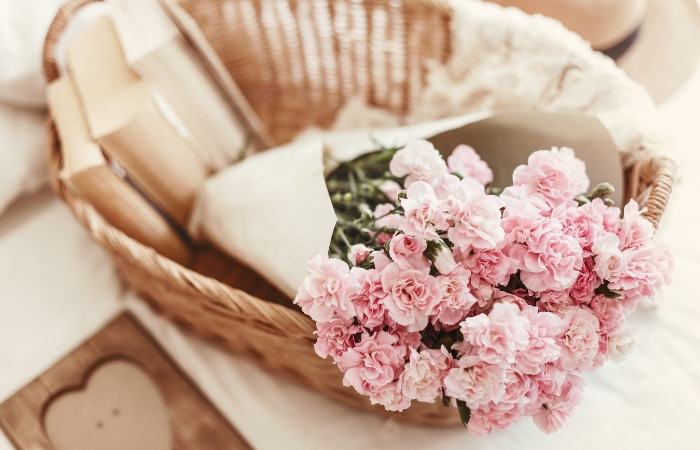
The Soft and Subtle Allure
Pastels, often described as “soft,” “gentle,” and “whisper-soft,” possess an inherent charm that instantly soothes the senses. These delicate colors evoke a sense of tranquility and calmness, making them an ideal choice for creating a peaceful atmosphere in your living spaces. Their understated beauty allows them to blend seamlessly with other elements of Shabby Chic decor, enhancing the overall elegance without overpowering the space.
Blending Whites and Light Pinks for a Delicate Ambiance
One of the most captivating aspects of pastels is their ability to harmonize effortlessly with whites and light pinks, creating a delicate and ethereal ambiance. Soft shades of pink, such as blush or rose, add a touch of femininity and romance to the decor, evoking a sense of nostalgia and elegance. When combined with whites, these hues open up the space, allowing natural light to dance through the room and creating an airy and inviting environment.
Incorporating Sky Blues and Pale Greens for a Tranquil Feel
Pastel sky blues and pale greens bring the serenity of nature into your home, infusing the space with a tranquil and refreshing feel. These colors are reminiscent of clear blue skies and lush meadows, invoking a sense of outdoor bliss within your interiors. When used as accents or as a primary color in a room, pastel blues and greens offer a soothing escape from the bustling world outside, providing a sanctuary for relaxation and rejuvenation.
Creating a Symphony of Pastels
One of the delights of working with pastels in Shabby Chic decor is the ability to create a symphony of colors that resonate with your personal taste. You can play with a range of pastel shades, combining them in various ways to achieve the desired ambiance. For instance, a gentle mix of pale blue, light pink, and soft lavender can create a serene and dreamy bedroom, while a combination of mint green, cream, and blush pink can fashion a chic and cozy living room.
Balancing Subtlety with Statement Pieces
While pastels are renowned for their subtlety, they can also serve as statement pieces when used thoughtfully. A bold pastel-hued sofa or an eye-catching accent wall can become a focal point in the room, drawing attention and infusing the space with a sense of individuality. The key to striking the right balance is to ensure that the statement pieces complement the overall decor, enhancing the Shabby Chic ambiance without overshadowing the soft and serene atmosphere.
Elevating Elegance with Neutral Tones
Neutral tones form the foundation of the Shabby Chic color palette, infusing spaces with a sense of timeless elegance and sophistication. In this section, we will explore the versatility of neutral colors and how they play a crucial role in creating a refined and harmonious atmosphere in your Shabby Chic interiors.
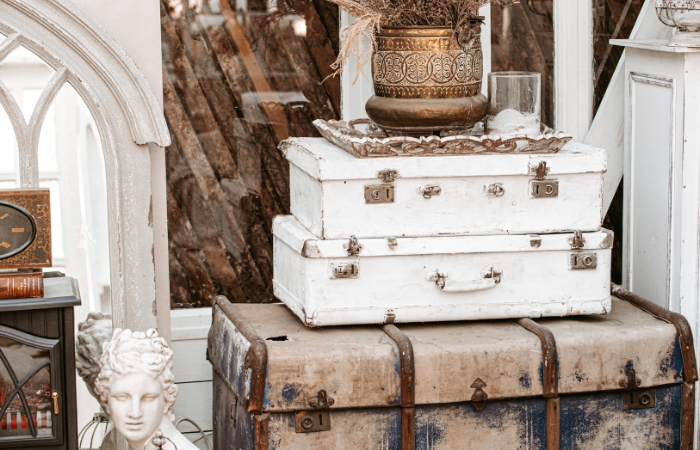
The Versatility of Neutral Colors in Shabby Chic Design
Neutral colors, such as beige, cream, and soft greys, serve as a versatile canvas upon which the other elements of Shabby Chic decor come to life. Their subtlety and understated beauty allow them to adapt effortlessly to various design styles and themes, making them an ideal choice for those seeking a decor approach that stands the test of time. Neutral tones provide a serene backdrop that enhances the overall elegance of your living spaces without overpowering the other decor elements.
Creating Warmth with Beige and Cream Shades
Beige and cream shades add a touch of warmth and coziness to your Shabby Chic interiors, creating an inviting and comfortable ambiance. These earthy hues evoke a sense of natural beauty, reminiscent of sandy shores and sun-kissed landscapes. When used on walls or large furniture pieces, beige and cream tones provide a neutral base that complements the soft pastels and vintage reds often found in Shabby Chic decor, creating a seamless blend of colors that exude grace and charm.
Adding Depth with Greys and Taupe Tones
Greys and taupe tones introduce depth and sophistication to your living spaces, elevating the elegance of your Shabby Chic decor. Light greys can create an airy and refined feel, while deeper greys and taupe shades add a sense of grounding and richness. When paired with soft pastels, these neutral tones add dimension and balance to the overall color scheme, allowing the decor to exude a sense of understated luxury and timeless appeal.
The Power of Texture and Layering
Incorporating neutral tones in Shabby Chic decor allows you to fully embrace the power of texture and layering. From the distressed surfaces of vintage furniture to the soft fabrics of cushions and throws, neutrals provide the perfect backdrop for showcasing the intricate textures that define Shabby Chic aesthetics. The interplay of light and shadows on different textured surfaces adds depth and visual interest to your interiors, creating a captivating and inviting environment.
Embracing a Monochromatic Palette
One of the delightful aspects of working with neutral tones is the option to embrace a monochromatic color palette. By using varying shades of beige, cream, or grey, you can create a cohesive and harmonious look that exudes sophistication and elegance. A monochromatic approach can be particularly effective in smaller spaces, as it visually enlarges the room while maintaining a sense of tranquility and simplicity.
Infusing Romance with Vintage Reds and Roses
Vintage reds and roses hold the key to infusing romance and passion into your Shabby Chic decor. In this section, we will explore the captivating allure of these rich hues and how they add a touch of nostalgia and warmth to your living spaces.
The Boldness of Red in Shabby Chic Interiors
Red is a color that commands attention and evokes strong emotions. In Shabby Chic design, vintage reds take center stage, adding a bold and passionate element to the otherwise soft and subtle color palette. From deep crimson to muted ruby, vintage reds infuse spaces with a sense of vibrancy and energy, making them an excellent choice for creating focal points and adding visual interest to your decor.
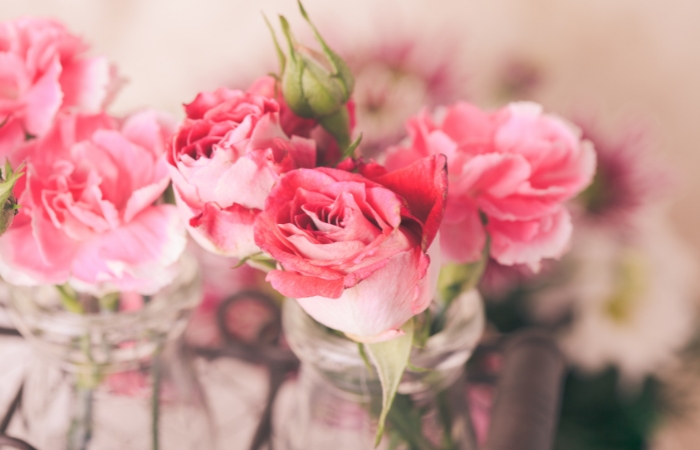
Balancing Passion with Softness: Rose-inspired Shades
While vintage reds exude passion, the inclusion of rose-inspired shades introduces a delicate and feminine touch to the decor. Soft pinks and dusty roses evoke a sense of romance and nostalgia, reminiscent of blooming gardens and vintage roses. These gentle hues perfectly complement the other elements of Shabby Chic design, creating a harmonious balance between passion and softness, elegance and subtlety.
Incorporating Vintage Reds and Roses in Decorative Elements
To infuse your living spaces with romance, consider incorporating vintage reds and roses in decorative elements. Vintage red throw pillows, rose-patterned curtains, or a beautiful floral rug can instantly transform the ambiance and add a romantic flair to your rooms. Additionally, artwork featuring red roses or vintage botanical prints can become eye-catching focal points, drawing attention and admiration from your guests.
Using Vintage Reds in Furniture and Accents
For those who prefer a bolder statement, vintage reds can be embraced in furniture and accent pieces. A vintage red armchair or a crimson-painted side table can become striking additions that command attention and become conversation starters. The key to successfully using these bold hues is to balance them with the softer elements of your decor, allowing the vintage reds to shine while maintaining a cohesive and elegant atmosphere.
Blending Vintage Reds and Roses with Neutrals and Pastels
To achieve a well-balanced and visually appealing decor, it’s essential to blend vintage reds and roses with the neutral and pastel tones that define Shabby Chic design. Pairing vintage reds with beige, cream, or soft grey creates a sophisticated and timeless look, allowing the rich hues to stand out while maintaining an overall sense of harmony. Similarly, combining rose-inspired shades with soft pastels enhances the romantic ambiance and adds a touch of vintage charm to your interiors.
Reviving Rustic Charm with Earthy Tones
Earthy tones play a pivotal role in reviving rustic charm in Shabby Chic interiors. In this section, we will explore the natural beauty of these colors and how they infuse spaces with a sense of warmth, grounding, and connection to nature.
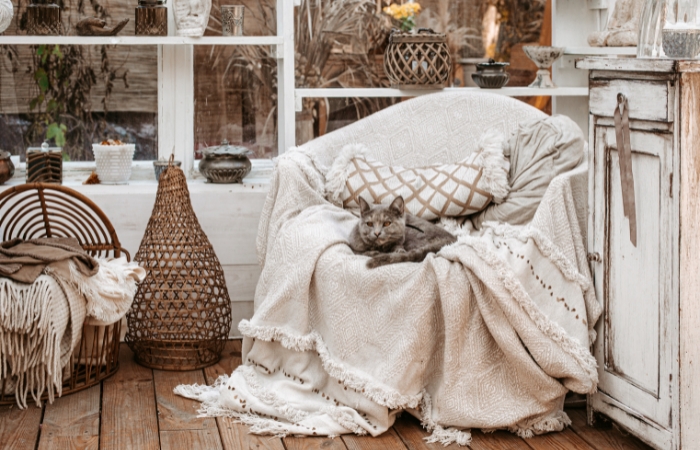
Embracing Nature’s Beauty with Earthy Hues
Earthy tones, such as browns, tans, and greens, are inspired by the beauty of the natural world. These colors evoke the warmth of sunlit landscapes, the richness of fertile soil, and the tranquility of lush forests. In Shabby Chic design, incorporating earthy hues allows you to bring the outdoors inside, creating a sense of harmony and serenity in your living spaces.
Incorporating Browns and Natural Wood Tones
Brown is a versatile and foundational earthy tone that is often associated with rustic charm. Incorporating brown in wooden furniture and decor elements adds a touch of warmth and authenticity to your interiors. Natural wood tones provide a beautiful contrast to the soft pastels and neutral hues prevalent in Shabby Chic design, infusing the space with a sense of rustic elegance and coziness.
Harnessing the Serenity of Green and Blue-Greens
Green and blue-green earthy tones capture the essence of nature’s tranquility and harmony. These colors can be introduced through potted plants, botanical prints, or soft furnishings, creating a refreshing and calming atmosphere in your Shabby Chic interiors. Green also complements the vintage reds and roses, adding a touch of balance and contrast to the color palette.
Blending Earthy Tones with Pastels and Neutrals
The key to successfully reviving rustic charm with earthy tones lies in blending them seamlessly with pastels and neutrals. Combining earthy hues with soft pastels enhances the natural beauty and adds depth to your decor. For instance, pairing a sage green with a soft pink creates a harmonious and romantic ambiance, reminiscent of a blooming garden. Additionally, integrating earthy tones with neutrals like beige or cream allows them to stand out without overpowering the overall decor.
Creating a Cozy and Inviting Atmosphere
Earthy tones contribute to creating a cozy and inviting atmosphere in your living spaces. Whether it’s through a vintage wooden chest, a woven area rug, or earthy-toned cushions, these elements add texture and comfort to your decor. The interplay of different earthy materials and textures further enhances the rustic charm, evoking a sense of nostalgia and well-lived elegance.
Practical Tips for Choosing Shabby Chic Paint Colors
Choosing the perfect Shabby Chic paint colors for your home can be an exciting yet daunting task. In this section, we will provide you with practical tips to guide you through the process and help you create a harmonious and elegant color palette that reflects the timeless beauty of Shabby Chic design.
Evaluating Natural Lighting and Room Size
Before selecting paint colors, it’s essential to consider the natural lighting in your space and the size of the room. Rooms with ample natural light can handle darker or bolder colors, while rooms with limited light may benefit from lighter and airier hues. For small rooms, opt for soft pastels or light neutrals to create the illusion of a more open and spacious environment. In larger spaces, you have more flexibility to experiment with a broader range of colors.
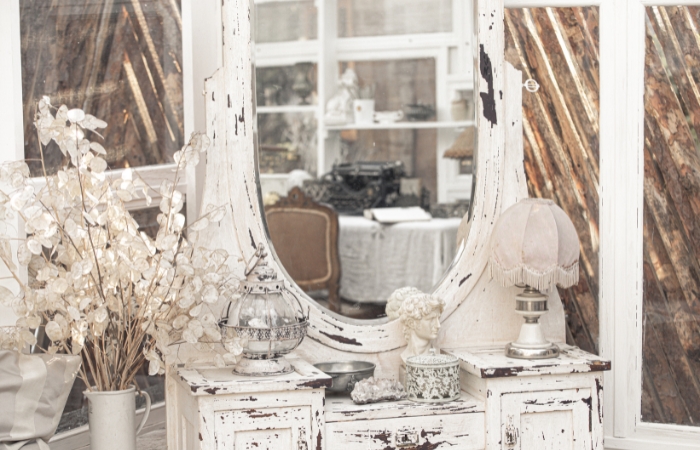
Considering Existing Furniture and Decor Elements
Take a look at your existing furniture and decor elements to determine the color direction for your Shabby Chic paint palette. If you have vintage-inspired furniture with distressed finishes, consider choosing paint colors that complement or contrast with those pieces. Neutral tones often work well as a base, allowing you to introduce pastels, vintage reds, or earthy tones as accents in your decor. By incorporating colors that harmonize with your existing pieces, you create a cohesive and well-curated space.
Sample Testing and Visualizing the End Result
Before committing to a paint color, it’s crucial to test samples on your walls. Paint colors can look different in various lighting conditions, so apply samples in different areas of the room and observe how they appear throughout the day. Take note of how the colors interact with your existing decor and furniture. Additionally, use color swatches or visualization tools to see how the selected colors complement each other and the overall ambiance you want to create.
Layering Paint Colors for a Distinctive Shabby Chic Look
A hallmark of Shabby Chic design is the art of layering paint colors to achieve a distinctive and weathered look. Consider using a two-tone or multi-tone approach to add depth and character to your walls or furniture. For instance, apply a light pastel as the base color, followed by a slightly darker shade of the same color or a complementary hue as an overlay. This technique creates a beautiful patina that accentuates the Shabby Chic style.
Mixing and Matching Pastels, Neutrals, and Vintage Reds
Don’t be afraid to mix and match different color families in your Shabby Chic decor. Combining pastels, neutrals, and vintage reds can create a captivating and well-balanced color palette. Consider using pastels as the dominant colors for walls and larger surfaces, while neutrals provide a neutral backdrop and vintage reds add pops of passion in accents or decorative elements.
Using Patterns and Textures to Enhance Shabby Chic Aesthetics
Patterns and textures can further elevate the charm of your Shabby Chic paint colors. Incorporate patterned wallpapers or stenciled designs on accent walls to add visual interest and a touch of vintage elegance. Additionally, using different textured finishes, such as distressed or washed effects, can enhance the weathered and lived-in look, amplifying the overall Shabby Chic aesthetics.
Conclusion
Remember, Shabby Chic is all about finding the perfect balance between old and new, creating spaces that exude a sense of history and nostalgia while remaining effortlessly chic and inviting. The paint colors you choose play a pivotal role in achieving this harmonious blend of elements, allowing you to express your unique style and personality in every brushstroke.
Whether you opt for dreamy pastels, soothing neutrals, passionate vintage reds, or earthy tones, the key is to let your imagination run wild and infuse your home with the romance and timelessness of Shabby Chic design.


